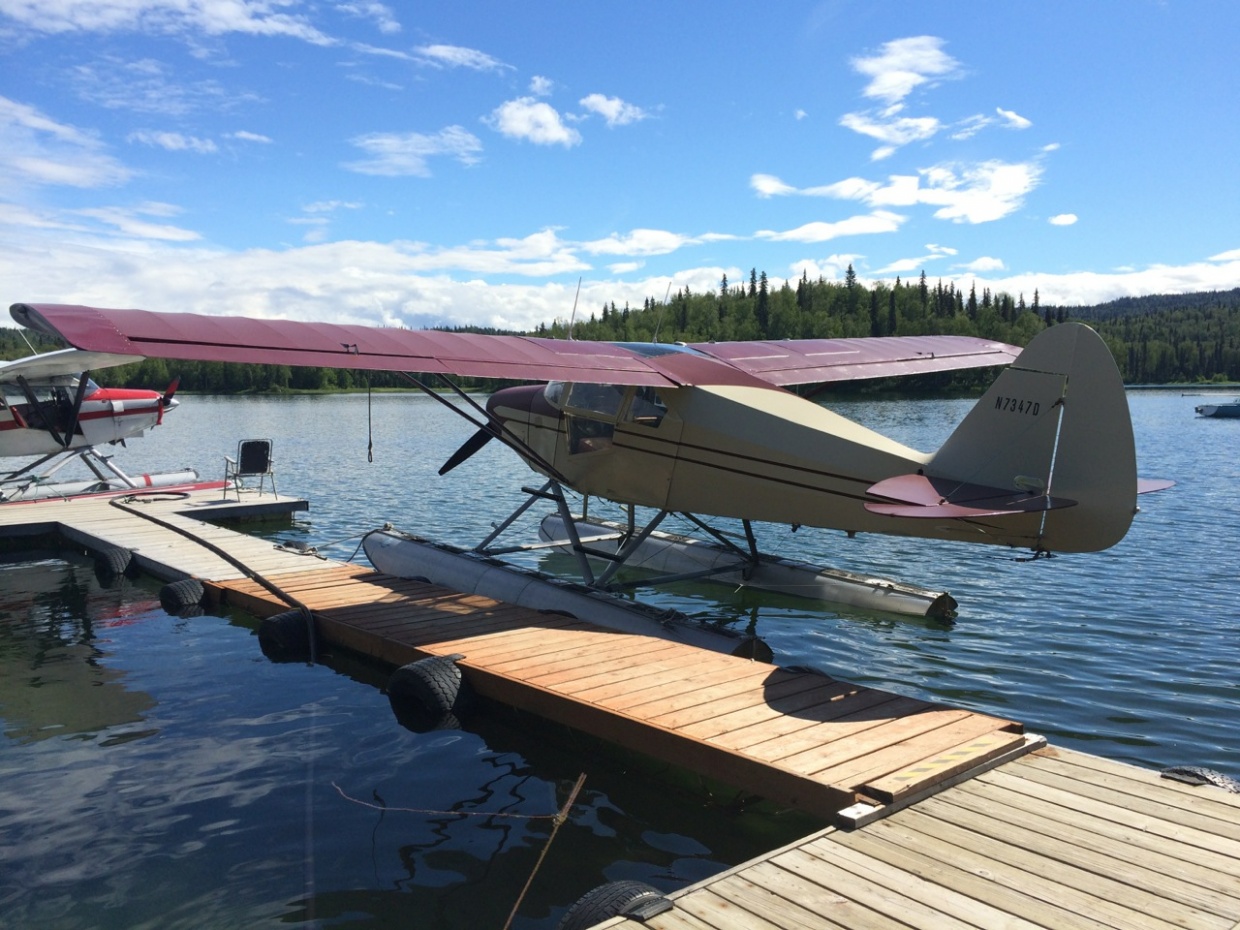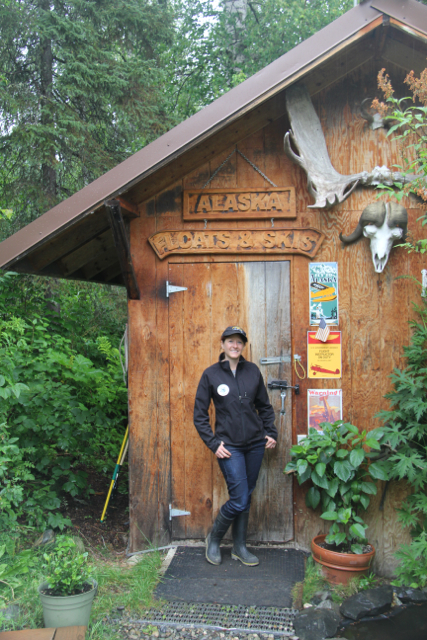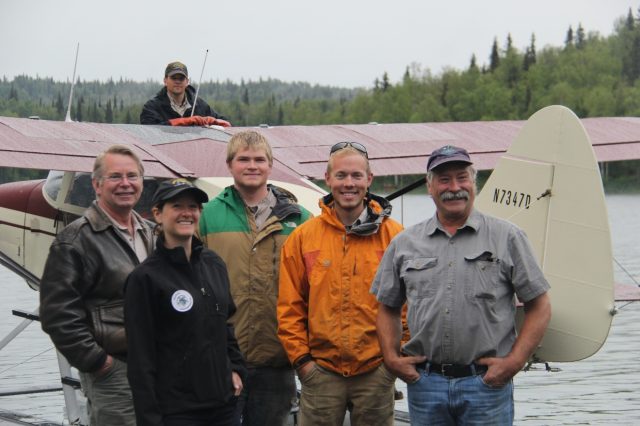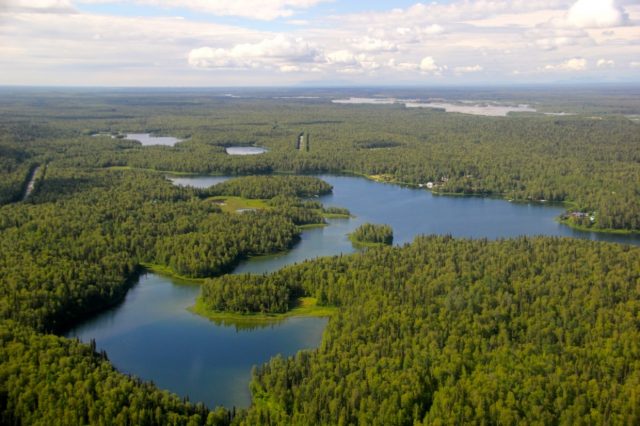If you haven’t thought about adding a Seaplane rating to your license, you should! I’ve considered it for years, however it wasn’t until this summer, 2014, that I put my plan in place. My only regret is that I didn’t do it sooner! On the other hand, if I had then I probably would only be flying Float planes!
While up in Alaska for the Iditarod earlier this year – Flying in Alaska – I explored options for obtaining my rating in our northernmost state. This summer I was flying back up to Alaska in the CJ3 and had enough time to obtain the rating. I found many good options for the course, however Alaska Floats & Ski owned by Don Lee looked like the best course. They offer many packages, including one with lodging, which worked great for my needs. I wanted to be as close as possible to the planes! Don’s Alaska Floats & Ski is located on beautiful Christiansen Seaplane Base (AK8).
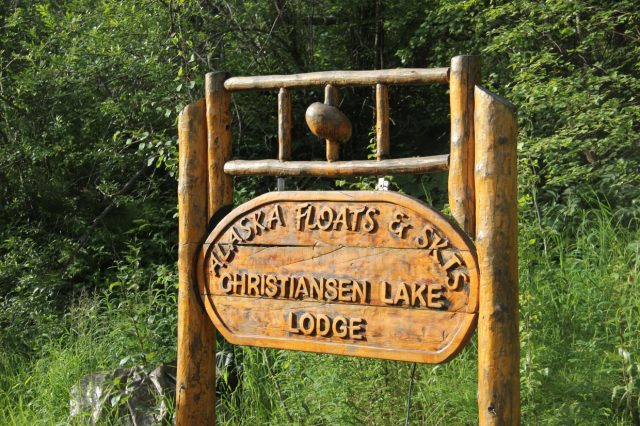
Alaska Floats & Ski – Christiansen Seaplane Base
Located only a few miles from Talkeetna Airport (PATK) and the adjacent town, it is a spectacular location. Talkeetna is about 2.5 hours from Anchorage on the Parks Highway, and 2.5 hours from Denali Park. One of the great things about having a plane in Talkeetna, is you can fly to Denali in only 40 minutes in the PA-22 (Pacer) for an incredible view (more later).
I arrived at Don’s place on Monday morning and Lindsay, the Office Manager, quickly greeted me at their FBO.
Lindsay showed my their lodge and let me choose between the Cessna and Piper rooms. It was a tough choice! The rooms are very nice, with a kitchen in the lodge if you want to prepare your own meals. The lodge is only a few steps from the dock. When I wasn’t flying, or sleeping I could be found studying, or writing, by the dock – even if it was raining. Even at 11 p.m. I would be sitting by the dock enjoying the almost endless daylight.
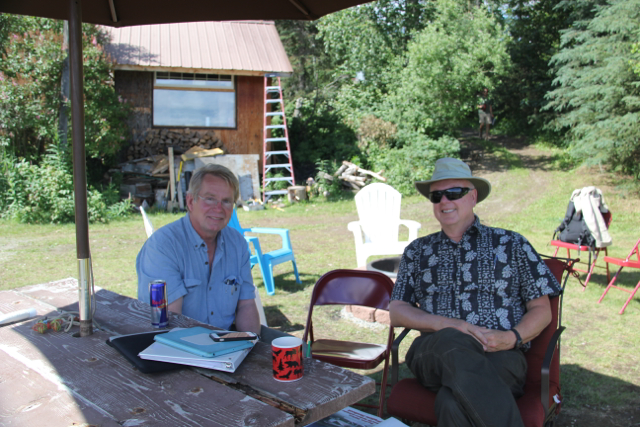
Ground school with my CFI – Roger Anderson
Alaska Floats & Ski has a number of aircraft for their bush and float courses, some of which are converted to skis for the winter. They typically fly Piper Pacers (PA-22) in their programs. Here are some of their fleet, with the bush planes kept at the Talkeetna airport.
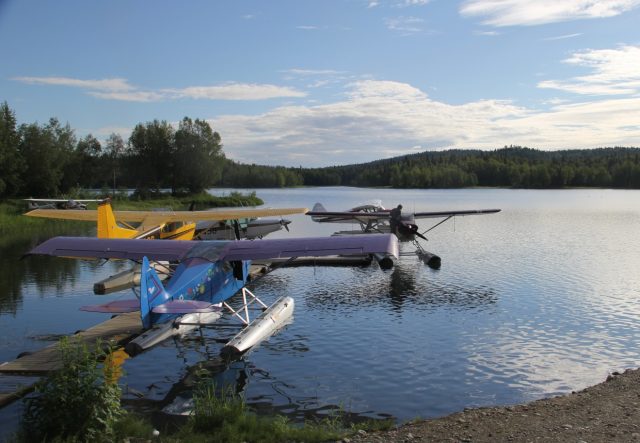
Alaska Float & Ski Float Plane Fleet
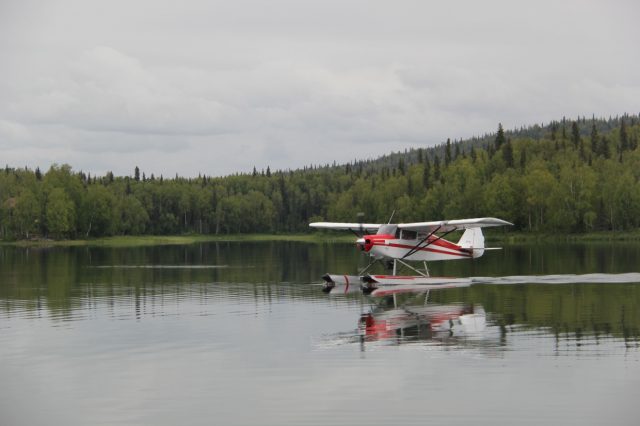
N7150K – Taxiing In at AK8
My primary training platform was N7347D, a very nice PA-22/20S. With the floats, it took some time to get used to using more rudder than I’ve used in land planes. It reminded me of sailplanes, which are also more sensitive to rudder input. Once you get accustomed to that, it becomes second nature.
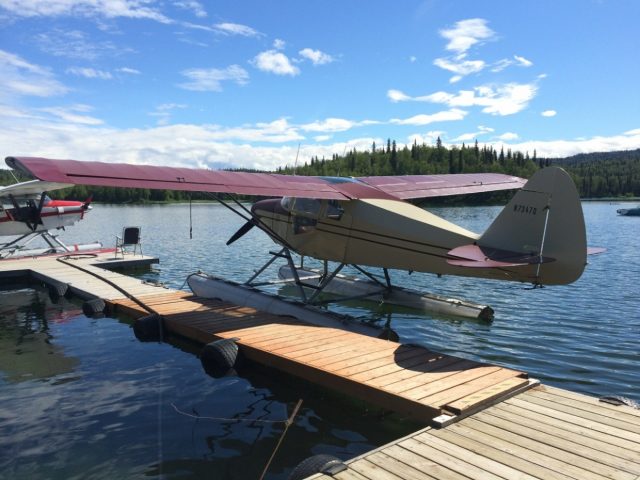
N7347D – My training platform
Don has a very welcoming staff, with a number of CFIs, all of whom have extensive experience across the fleet. Don and Roger are also A&Ps, and their maintenance hangar is adjacent to the dock. Sometimes after flying, we would sit by the dock and have beers — at ‘ramp temperature’.
Seaplane Flights
We started ground school just after I arrived, then Roger and I started flying that same afternoon, taking my first flight in a Piper Pacer, let alone a float plane. After donning a life vest, I learned that you want to have the plane ready to start the minute you are cast off from the dock – you don’t want to be drifting in a powerless plane in the lake. We started off by learning to taxi – without brakes! The floats have very small water rudders which are somewhat effective if you are moving. We taxied to the north end of Christiansen Lake – which was fun by itself, watching the water go by with my door open.
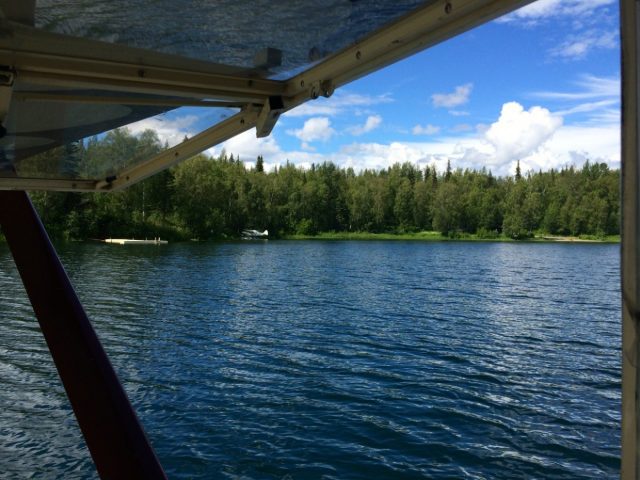
Taxiing for Takeoff – view from my cockpit window
The water rudders on the floats are only down when taxiing at idle or using the Plough technique, otherwise they are up. The trick is to make a 180 degree turn and have the water rudders up by the time you are straight for takeoff. Too early in the turn, and your can’t turn, too late and you are busy with other takeoff items. With enough turning momentum you can raise the water rudders by 135 degrees, then add power and you are ready to go when lined up.
With full power, 10 degrees of flaps, and full back elevator we accelerate, albeit slowly. As you accelerate the back elevator is gradually reduced until the plane settles ‘on the step’. The step planing position is when the airplane is on the mid point of the floats and has the optimum, smallest, contact point with the water. It took me some time to actually feel when that attitude is obtained. Once there your elevator pressure is almost neutral and you wait to build up speed to attempt lift off around 50 MPH.
We had a smooth (glassy) surface which is actually more challenging than a rough water surface since the surface tension wants to keep the floats on the water. One way to accelerate the process is to pull the plane onto one float – reducing the drag. Roger taught me to bump the flaps up, just a little and turn the ailerons to life a float. Presto! We are airborne – looking at the trees at the end of the lake. I took advantage of the lower terrain on the left end by turning the airplane just over the water as I climbed.
In the photo we took off from the far right, then followed the lake to the upper left on the first departure. The lodge and dock on the the far side in the middle. What a thrill!
We headed to a series of lakes, the first being Rockys Lakes. You always assess the landing area, including the winds, before landing. Without an ASOS or even a wind sock, you are dependent upon your own observations. If there is wind, the upwind portion of the lake will be smooth – in the wind shadow. Ripples will start to form around 2 knots, and waves at 4 kts. As the lakes increase in size, the waves also get larger farther downwind. All things to consider, including trees which surround most of the lakes I used!
Splash-n-Gos Getting My Seaplane Rating
Roger did a great job preparing for my first wet landing. After assessing the first lake, I established a pattern and slowly decelerated to 80 MPH, flaps at 10 degrees. (G)as (U)ndercarraige – floats down and gear up (for amphibs) (M)ixture (P)ower (throttle, carb heat test). Usually when water is on the runway, I’m considering hydroplaning – this time I’m landing in water.
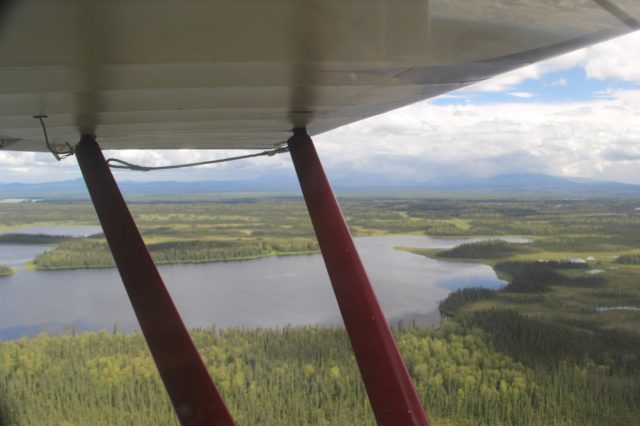
Rockys Lake
I was glad that Roger picked a big lake for the first landing. Our goal was to land over the small peninsula just forward of the strut, a low lying area of marsh. The wind was light which made it nice, however the surface was fairly smooth which also removes some of the visual clues. When setting up for landing on water, you don’t flare but attain a landing attitude which is close to level.
My first touch down was a bit rough and the pitch was a little low, so we ended up with a bow wave in front of the float. The lift off was quick, since the bow wave reduces the surface tension and up we went. I love touch-n-gos and the opportunity to do a large number of splash-n-gos was awesome!
We then practiced glassy landings, one of the most challenging landings. When the surface is glassy, or you have reduced visibility, it is difficult to ascertain your height above the water. The trick is to choose a visual reference (trees, grass, etc.) before you fly over the water. At that point you set your final landing attitude. The altitude above the water, is now totally controlled by power — with the landing attitude constant. You must avoid looking at the water below and instead focus out in the distance. You no longer have your side visual references. Surprise!!! You landed. Roger said every glassy landing is a surprise. On one landing I was so close to the marsh on final, that I landed on it then slide onto the water! It was a very smooth landing in the water.
Next was confined landings over trees. Similar to a short-field landing on a runway, you come over the trees on a steep approach with 30 degrees of flaps, round out to the landing attitude then – Splash! It was more fun than any short field landing I’ve ever done.
Ten landings later, we headed to Fish Lake on the way back to base. Before landing at Fish Lake we saw perhaps the tallest structure out side of Anchorage! It appeared that the owner was never satisfied with the view from their house, so they kept building another level! I hope my wife doesn’t want me to do the same thing to our house —- it would take time from flying.
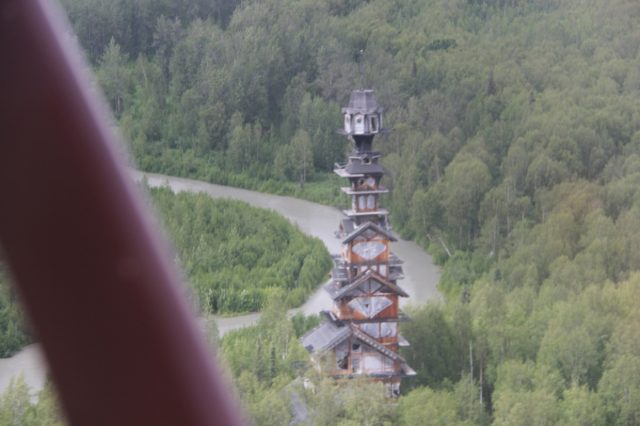
When a View is Really Important
On the way back to AK8 we practiced on Fish Lake, which is just a few miles from our base. It has a nice approach over the road to Talkeetna, then over the trees.
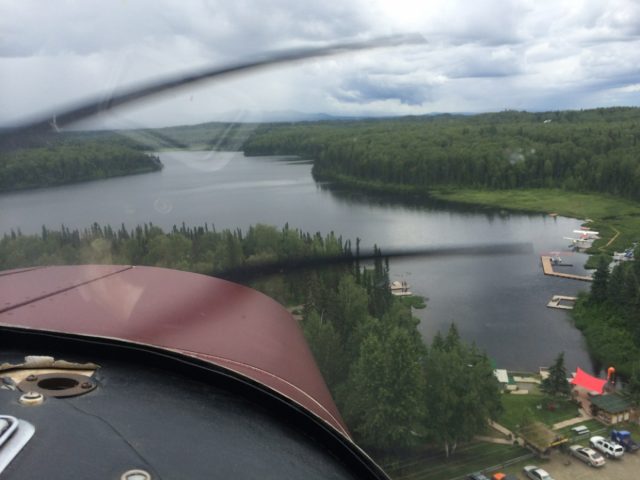
Fish Lake – Short Final
In the evening, which is still daylight since the sun didn’t set until almost midnight, Roger and I decided to explore some mountain lakes – Rainbow, Sockeye, and Pineapple Man. All of them are beautiful, with Pineapple Man offering some challenges since it is in a valley and on approach you can’t see the lake until you are almost over it. Roger taught me to use ‘lead-in’ lakes, flying over the first, then turn left 80 degrees for the second, then finally seeing Pineapple Man after passing the second lake. Since the lake has some large rocks, you fly over it for 1/2 mile, then turn right and Splash!
These lakes became my favorites, the location in the mountains and unique challenges made for fun landings. Over 2 flights we made a large number of landings, many of which were on glassy surfaces. On Rainbow, it was so calm that even on multiple Splash-n-Gos I could still see my wake. We also practiced step taxiing and that wake also remained for several minutes.
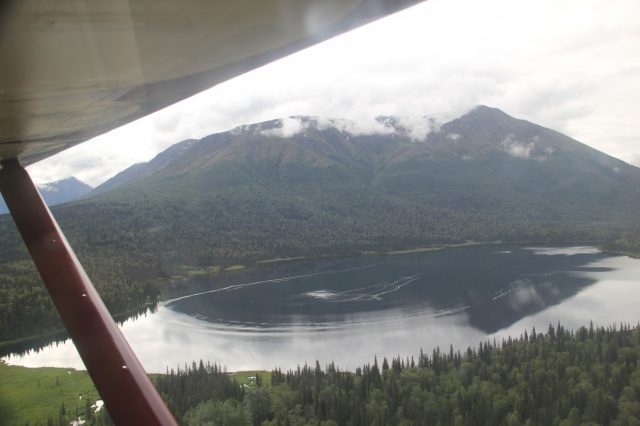
You can see the wakes from the step taxi and two previous landings
Talkeetna
Talkeetna is a quaint town, just a few minutes from Alaska Floats & Ski. It is only a few blocks long, and is worth the visit. There are various places to stay, shop, and eat. One of my favorites is the Wildflower Cafe, offering some of the best meals in Alaska. You will find many other options in the town, including homemade ice cream!
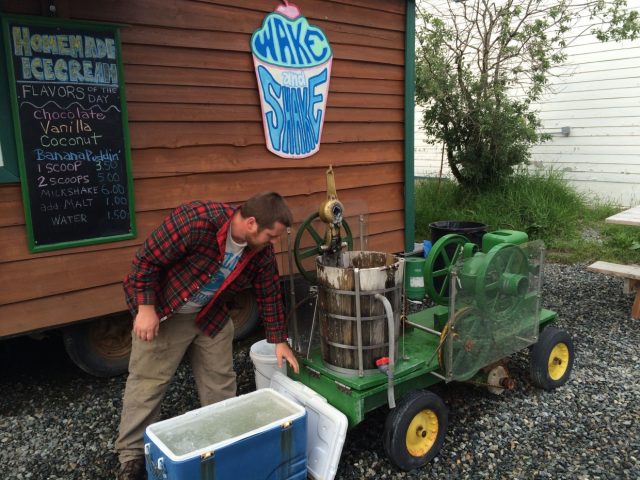
Homemade Ice Cream at Wake and Shake – Talkeetna
Side Flight – Denali Glacier
Roger signed me off for my checkride after our third flight, however I wanted to fly more. We decided to fly up the Kahlitna Glacier which is the largest glacier in the Alaska Range, land at a few lakes on the way back, then fly down the Chitna River back to base. We lashed fishing poles to the wing struts, just in case we wanted to fish on one of the lakes. Denali was obscured in clouds, however the flight up the glacier was still spectacular. Flying under the clouds, we explored all the way up to the base of Denali, and could see Mount Foraker (17,402) above us. The glacier is covered with mountain debris on the lower sections, the result of extensive erosion by the moving ice. Flying low over the glacier we could view the deep glacier blue water in small pools. Along the way we viewed extensive ice falls, and flew up over the base camp used at the base of Denali for the climbers.
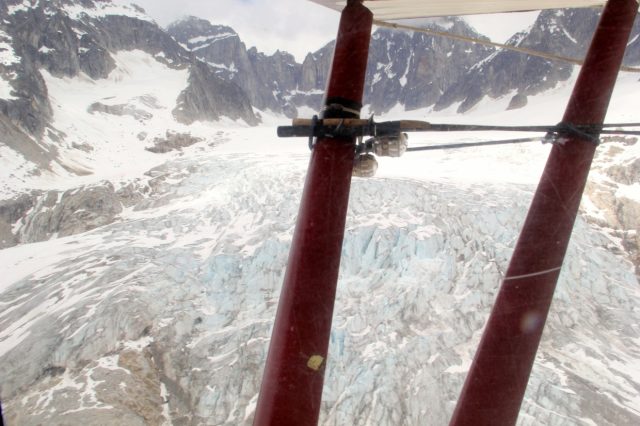
Flying up the Kahlitna Glacier – fishing poles ready
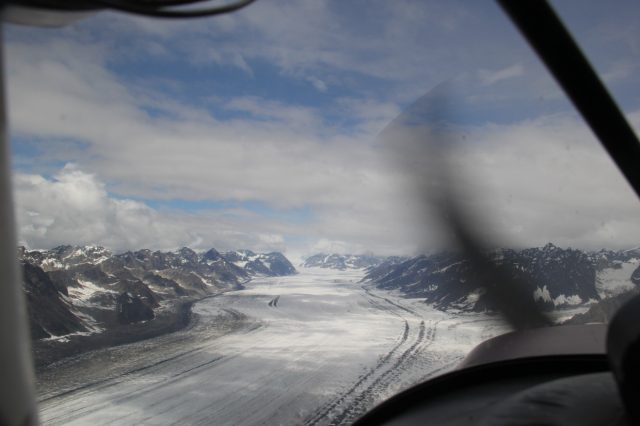
Kahlitna Glacier
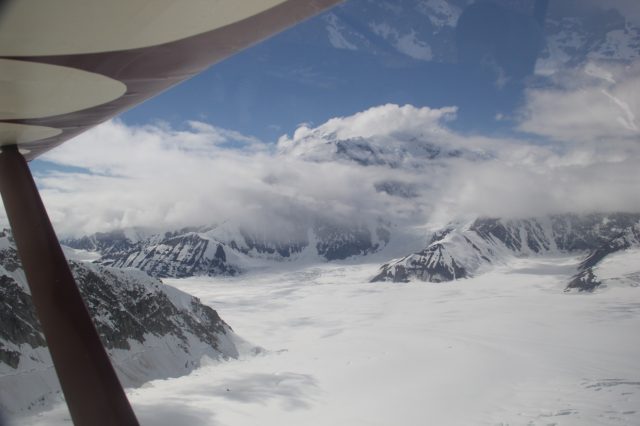
Mt. Foraker – AK
The Checkride
Now was the time to prove to the FAA that I could fly float planes. Ray Hodges, was the FAA-designated examiner. Ray owns his own float plane (PA-12) and flew up from Palmer to administer the examination. Ray immediately put me at ease, then presented me with a 6 page written test. The items dealt with aerodynamics, FAA regulations, and general knowledge on how to safely operate sea planes. I had studied over the previous 2 days with material provided by Roger, which did a great job of preparing me for the check ride. The ground portion of our check ride took a bit over 2 1/2 hours, then it was off to demonstrate my skills in accordance with the Practical Test Standards (PTS). We flew over to Larsen Lake, close by to AK8. The surface was calm, so most of my landing were made using the glassy techniques. The check ride included various maneuvers including: step turns, plough turns, high altitude operations, constrained (short) operations, glassy landings, and a few others. Since Roger had thoroughly prepared me for the test, it was not a surprise.
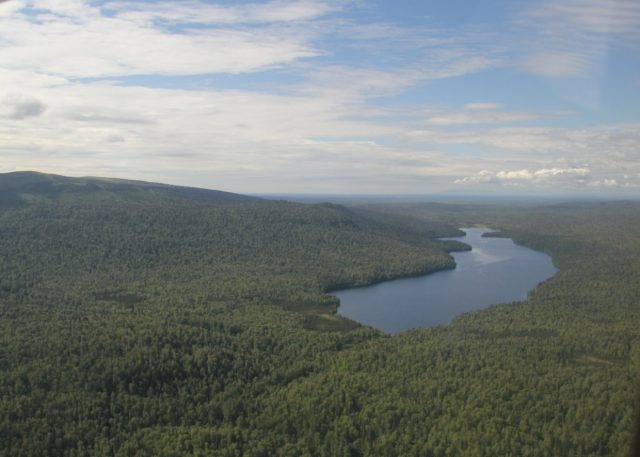
Larson Lake – Checkride Central
It was great landing back at AK8 and then Ray told me I had passed and now was a Commercial Single Engine Seaplane pilot!
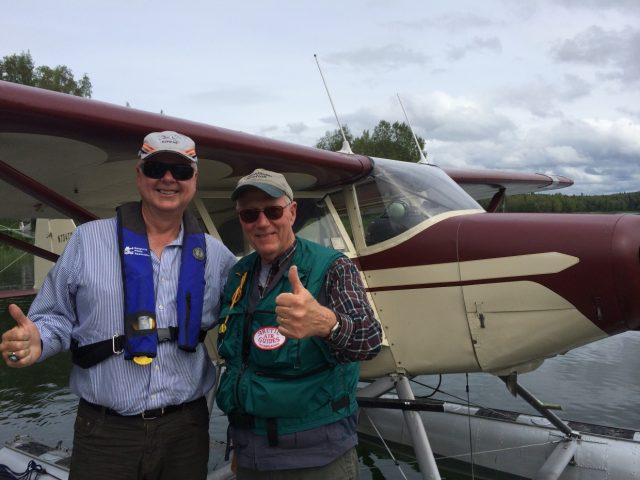
Rich and Ray Hodges DPE with SES
Hooked
Right after receiving my new rating, I wanted to fly again. I talked with Don Lee and I wanted to explore the Susitna River. With the recent rains it was moving fast with the high water and looked like a challenge. Don taught me how to determine the best landing option, especially with downed trees in the river, and taxiing in the moving river up to the shore for beaching. It was interesting landing in such fast moving water, an opportunity I didn’t want to miss. Don is an excellent CFI, with considerable experience and I realized I only touched the surface of this great opportunity to fly a float plane.
After arriving back in Anchorage, the first thing I did was go looking for another float plane to fly! I scoured the Lake Hood Seaplane Base (PALH), the largest in the world, and found a Super Cub to rent with a CFI. Richard Whyte at Acme Cub Training was available, so we went up to explore lakes north of Anchorage. PALH has both water runways, and runways. It is directly adjacent to Anchorage International Airport and it is an experience not to be missed. You are flying float planes in the pattern, watching 747s landing nearby.
The Super Cub flies differently than the Pacer, and has 20 additional horse power. Landing is very similar with minor changes in landing attitude. I had never flown a Super Cub, yet the training I had received helped in flying that aircraft. After an hour and half, it was time to head back to Anchorage.
Flying float planes is an incredible experience, and I recommend it highly. You can’t beat Alaska for the variety of lakes to explore and Alaska Floats & Ski provide a great opportunity to explore those lakes.
One caveat, once you fly on floats you might get hooked! I’m now finding myself looking in Controller for Lake Amphibians — just looking of course 🙂

